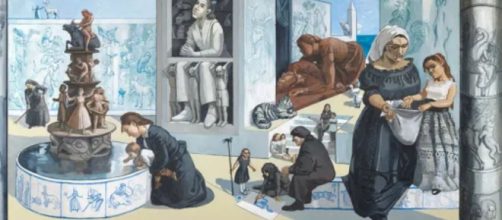What was the National Gallery thinking?
In 1990, this London treasure house commissioned Paula Rego to paint a 32-foot mural for its dining room. Why? Why relegate an artist's work that the BBC calls "violent" and "about rebellion and rage" to a restaurant?
Granted, Rego kept rage out of the dining room mural, but her choice of subject is portentous in another way. She based her imagery on a 15th-century altarpiece, "Madonna of the Swan" by Carlo Crivelli. What was the attraction?
Cherchez la femme
One look at Crivelli's work, and you know what moved Rego.
It's full of women – her favorite subject – in this case, the Virgin Mary, Saint Catherine, and Mary Magdalene.
Rego, a feminist known for depicting subjugated women, took the opportunity to make these women of old contemporary. And, as the National Gallery curator Colin Wiggins put it, she took Crivelli's idea and "flipped it on its head."
Certainly, Rego's depiction of Mary is less airy and calm. Now no longer the Queen of Heaven with the Christ Child on her knee, you see her struggle with the weight of her son's dead body. You can almost hear her grunt with the effort.
By re-staging the biblical story, Rego bids you to see a familiar story in a fresh way. It's no wonder that her favorite painting is Max Ernst's picture of the Virgin Mary spanking her child.
As for putting her painting of female saints on a dining room wall, Rego didn't see that as an issue. There are plenty of women in the restaurant workforce, she said, referring to cooks, cleaners and waitresses.
Shaking off the male gaze
Rego talked about her offbeat renditions of women in the Bible in a 2003 interview with Richard Zimler, whose novel "The Gospel According to Lazarus" has been praised as "brave." The tag fits her, too.
Rego told Zimler, "If there is anything new about these representations of the Virgin, it is the fact that they were done by a woman, which is very rare. . . . It always used to be men who painted the life of the Virgin, and now it is a woman. It offers a different point of view because we identify more easily with her."
To make Rego's point in the mural, she tells the story of Judith, the Biblical heroine who saved her town by decapitating the leader of an invading army.
The painting shows her inviting a young girl to peek into the contents of a bag (presumably holding the general's severed head).
In another Biblical story, Rego describes a woman in brown whispering to another woman in white, and you just know that's Elizabeth, John the Baptist's mother and Mary talking about their pregnancies.
This is a monumental work in more ways than size. The weight of the subject seems out of place in a dining room. At the moment, this is not a problem since the restaurant is under renovation and the mural hangs in the museum.
The museum exhibit of Rego's mural is on view until October 29. Here's hoping the National Gallery sees the error of its ways and keeps the mural in its exhibit hall rather than an eatery.


